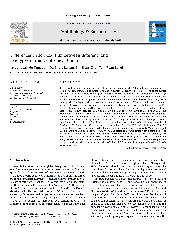摘要
it is crucial to advance the understanding of the soil carbon dioxide (CO2) flux and environmental factors for a better comprehension of carbon dynamics in subtropical ecosystems. Red soil, one of the typical agricultural soils in subtropical China, plays important roles in the global carbon budget due to their large potential to sequester C and replenish atmospheric C through soil CO2 flux. We examined the relationship between Soil CO2 flux and environmental determinants in four different land use types of subtropical red soil-paddy (P), orchard (O), woodland (W) and upland (U) using static closed chamber method. Objectives were to evaluate the relationship of soil temperature, water-filled pore space (WFPS), and dissolved organic carbon (DOC) with the soil CO2 flux. Soil CO2 fluxes were measured on each site about every 14 days between 09:00 and 11:00 a.m. during 14-July 2004 to 25-April 2007 at the experimental station of Heshengqiao at Manning, Hubei, China. Soil CO2 fluxes revealed seasonal fluctuations, with the tendency that maximum values occurred in summer, minimum in winter and intermediate values in spring and autumn except for paddy soil when it was submerged. Further, significant differences in Soil CO2 fluxes were observed among the four soils, following the order of P > O > U similar to W. Average soil CO2 fluxes were estimated as 901 +/- 114, 727 +/- 55, 554 +/- 22 and 533 +/- 27 (+/- S.D.) g CO2 m(-2) year(-1) in paddy, orchard, upland and woodland soils, respectively. Variations in soil CO2 flux were related to soil temperature, WFPS, and dissolved organic carbon with a combined R-2 of 0.49-0.75. Soil temperature was an important variable controlling 26-59% of soil CO2 flux variability. The interaction of soil temperature and WFPS could explain 31-60% of soil CO2 flux variations for all the land use types. We conclude that soil CO2 flux from red soil is under environmental controls, soil temperature being the main variable, which interact with WFPS and DOC to control the supply of readily mineralizable substrates.
- 出版日期2008-9
- 单位华中农业大学
